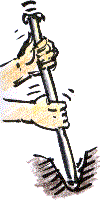
|
Mending FencesSaturday, 5th October 2002, West Yorkshire |
![]()
![]()
![]()
![]() Rocks |
History |
Workshop |
Links |
Home Page
Rocks |
History |
Workshop |
Links |
Home Page
![]()
 Making a couple of holes for fence stakes proves to be quite a task, especially as the best tools that I can find for the job are a spade and a length of metal piping.
Making a couple of holes for fence stakes proves to be quite a task, especially as the best tools that I can find for the job are a spade and a length of metal piping.The robin comes within two feet of of me as I work. If I had some mealworms I'd have it eating out of the palm of my hand.
Soil Profile
The soil is much thinner here by the back garden hawthorn hedge than it is in our well cultivated veg beds. After no more than a spade's depth I encounter clay that is almost brick hard. Amongst it there are fragments of the local bedrock, sandstone. Amongst the roots of the hawthorn I find it impossible to make any progress. I start by hammering in the length of piping, then I use it as a digging
stick to enlarge the hole, thumping it rhythmically into the ground. There's
a jarring break to the rhythm every time I hit a stone and I have to work
around it to prize it out. I'm sure that I've seen film of Kalahari bushmen
using the same technique to dig out tubers, lizards and termite nests but
I believe that they have a digging song to keep the rhythm going.
I start by hammering in the length of piping, then I use it as a digging
stick to enlarge the hole, thumping it rhythmically into the ground. There's
a jarring break to the rhythm every time I hit a stone and I have to work
around it to prize it out. I'm sure that I've seen film of Kalahari bushmen
using the same technique to dig out tubers, lizards and termite nests but
I believe that they have a digging song to keep the rhythm going.The Common Clay
The intractable clay and stony shards seem tough and unforgiving and yet they, the products of weathering of the bedrock, are the inorganic raw material from which the soil forms. This thin blanket of living soil is the basis of terrestrial ecology and of the bulk of our food supply. It's something of such fundamental importance to our countryside and to our well-being yet, hidden from sight for the most part, we so easily overlook it.Until it comes to digging a hole in it, that is!
![]()
Richard Bell,
wildlife illustrator
E-mail; 'richard@willowisland.co.uk'
![]() Next page |
Previous page |
This day last year |
This month |
Nature Diary |
Home Page
Next page |
Previous page |
This day last year |
This month |
Nature Diary |
Home Page
![]()